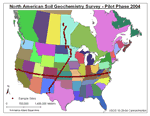
This report contains major- and trace-element concentration data for soil samples
collected from 265 sites along two continental-scale transects in North
America. One of the transects extends from northern Manitoba to the United
States-Mexico border near El Paso, Tex. and consists of 105 sites. The
other transect approximately follows the 38th parallel from the Pacific
coast of the United States near San Francisco, Calif., to the Atlantic
coast along the Maryland shore and consists of 160 sites. Sampling sites
were defined by first dividing each transect into approximately 40-km
segments. For each segment, a 1-km-wide latitudinal strip was randomly
selected; within each strip, a potential sample site was selected from
the most representative landscape within the most common soil type. At
one in four sites, duplicate samples were collected 10 meters apart to
estimate local spatial variability. At each site, up to four separate soil samples were collected as follows: (1) material from 0-5 cm
depth; (2) O horizon, if present; (3) a composite of the A horizon; and
(4) C horizon. Each sample collected was analyzed for total major- and
trace-element composition by the following methods: (1) inductively coupled
plasma-mass spectrometry (ICP-MS) and inductively coupled plasma-atomic
emission spectrometry (ICPAES) for aluminum, antimony, arsenic, barium,
beryllium, bismuth, cadmium, calcium, cerium, cesium, chromium, cobalt,
copper, gallium, indium, iron, lanthanum, lead, lithium, magnesium, manganese,
molybdenum, nickel, niobium, phosphorus, potassium, rubidium, scandium,
silver, sodium, strontium, sulfur, tellurium, thallium, thorium, tin,
titanium, tungsten, uranium, vanadium, yttrium, and zinc; (2) cold vapor-
atomic absorption spectrometry for mercury; (3) hydride generation-atomic
absorption spectrometry for antimony and selenium; (4) coulometric titration for carbonate carbon; and (5) combustion
for total carbon and total sulfur.
Version 1.0
|
| Posted July 2005 |
|
Part or all of this report is presented in Portable Document Format and Excel Spreadsheets. The latest
version of Adobe Acrobat Reader or similar software is required
to view it. If you wish to download the latest version of Acrobat
Reader free of charge, click here.
|
|

